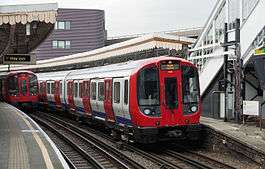Westbourne Park tube station
| Westbourne Park | |
|---|---|
 | |
 Westbourne Park Location of Westbourne Park in Greater London | |
| Location | Notting Hill |
| Local authority | Royal Borough of Kensington and Chelsea |
| Managed by | London Underground |
| Owner | London Underground |
| Number of platforms | 2 |
| Fare zone | 2 |
| London Underground annual entry and exit | |
| 2012 |
|
| 2013 |
|
| 2014 |
|
| 2015 |
|
| Railway companies | |
| Original company | Hammersmith and City Railway |
| Key dates | |
| 1 February 1866 | H&C station opened |
| 30 October 1871 | GW main line station opened |
| 13 March 1992 | GW main line station closed |
| Other information | |
| Lists of stations | |
| WGS84 | 51°31′16″N 0°12′04″W / 51.5211°N 0.2011°WCoordinates: 51°31′16″N 0°12′04″W / 51.5211°N 0.2011°W |
|
| |
Westbourne Park is a London Underground station in the Notting Hill area of The Royal Borough of Kensington and Chelsea. It is on the Circle and Hammersmith and City lines, between Ladbroke Grove and Royal Oak stations and is in Travelcard Zone 2.[2]
It is in close proximity with Harrow Road W9.[3] Tower Transit's Westbourne Park bus garage is opposite this station on the other side of the Great Western Road.[3]
History
Although the Metropolitan Railway had been extended to Notting Hill and Hammersmith on 1 June 1864 the first station by this name did not open until 1 February 1866.[4][5] In 1867, with the companies on better terms, the Metropolitan bought a share of the H&CR from the GWR, after which they eliminated the broad-gauge track and operated almost all the trains (the H&CR's identity being effectively lost).[4]
The original station closed on 31 October 1871 and was replaced the following day by a new station[4] constructed to the east of the original.[6] To remove this traffic from their own busy main line, the GWR built a new pair of tracks from Paddington to Westbourne Park, and on 12 May 1878 they opened a diveunder to remove conflicts where the service crossed the main line.[4][note 1] In February 1913 a bomb (possibly planted by the Suffragettes) was discovered at the station.
In 2009 the Circle line was extended to Hammersmith.[7] The line now operates between Hammersmith and Edgware Road via a single complete circuit of the previous route.[7][note 2] This was done with the aim of improving reliability by providing a place for trains to terminate after each trip rather than letting delays accumulate.[7] However, it means that no trains through Notting Hill Gate go east of Edgware Road.[7]
National Rail platforms
The Great Western Railway opened platforms on the Great Western Main Line on 30 October 1871 but these closed in March 1992. Closure notices had been posted on 13 December 1990 as the Up line through the station had a 30 mph speed limit which was unacceptable for the planned Heathrow Express services; instead of modifying the station's platforms, British Rail decided that it would be more cost-effective to dispense with them.[8]
Another station on the Hammersmith & City line, Royal Oak, was also served by the GWR but their services were withdrawn in 1934[9] Today the first stop out of Paddington is at Acton Main Line. Industrial archaeologists have found the remains of buildings including a broad gauge train shed for Brunel's original lines, a turntable, and engine sheds in excavations east of the station as part of the land clearance work for the Crossrail project.[10]
Connections
London Bus routes 7, 18, 23, 28, 31, 36, 70 and 328,[11] and night routes N28 and N31[12] serve the station. In addition, bus route 23 provide a 24-hour bus service.[11]
In popular culture
The station was featured in the video of the Boris Gardiner song "I Want to Wake Up with You".[13][14]
Notes and references
Notes
References
| Wikimedia Commons has media related to Westbourne Park tube station. |
- 1 2 3 4 "Multi-year station entry-and-exit figures" (XLS). London Underground station passenger usage data. Transport for London. April 2016. Retrieved 3 May 2016.
- ↑ Transport for London (January 2016). Standard Tube Map (PDF) (Map). Not to scale. Transport for London. Archived (PDF) from the original on 3 January 2015.
- 1 2 Google Maps – Westbourne Park Tube Station
- 1 2 3 4 5 Clive's Underground Line Guides – Hammersmith & City line
- ↑ Butt 1995, p. 244
- ↑ Rose 2007
- 1 2 3 4 5 Clive's Underground Line Guides – Circle line
- ↑ Leigh, Chris, ed. (March 1991). "Rail report: Westbourne Park closure". Railway World. 52 (611): 165.
- ↑ Chronology of London Railways by H.V.Borley- page78/79
- ↑ Hamish McDougall (2014). "Crossrail uncovers Brunel's railway heritage". Crossrail. Retrieved 17 October 2014.
- 1 2 "Buses from Westbourne Park" (PDF). Transport for London. 26 October 2014. Retrieved 16 March 2015.
- ↑ Westbourne Park Underground Station – Bus
- ↑ Tube Facts – Music Videos filmed on the tube
- ↑ Westbourne Park tube station is seen in the video from 0:58 to 1:43.
Bibliography
- Butt, R.V.J. (1995). The Directory of Railway Stations. Yeovil: Patrick Stephens Ltd. ISBN 1-85260-508-1. R508.
- Rose, Douglas (December 2007) [1980]. The London Underground: A Diagrammatic History (8th ed.). Harrow Weald: Capital Transport. ISBN 978-1-85414-315-0.
| Preceding station | Following station | |||
|---|---|---|---|---|
towards Hammersmith | Circle line | |||
| Hammersmith & City line | towards Barking |